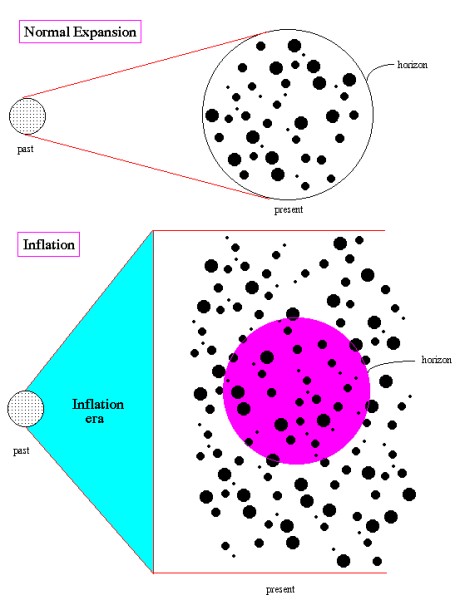Quando observamos galáxias distantes vemos a luz que estas emitiram no passado. Será que o que vemos também não poderia ser a emissão do nosso passado,
da nossa própria Galáxia talvez há alguns milhões de anos atrás?
Um raio de luz emitido pela Nossa Galáxia (ou por qualquer outra) necessitaria de um intervalo de tempo superior à idade do Universo para voltar ao ponto de partida. De acordo com o Modelo do
Big Bang Inflacionário o Universo é muito maior do que aquilo a que chamamos
Universo Observável.
A introdução da Inflação no modelo standard do Big Bang permite solucionar uma série de questões que este deixava em aberto (como, por exemplo, o facto da radiação cósmica de fundo ser praticamente homogénea e isotrópica,
ou seja, não depender do ponto em que estamos nem da direção em que olhamos).
O mecanismo da inflação foi responsável pela expansão exponencial do Universo
nos instantes iniciais logo a seguir ao Big Bang: o Universo expandiu-se de um
factor da ordem de 10 elevado a 50 (ou superior). Devido a isso o Universo Observável, a parte
do Universo que conseguimos observar (representado pelo circulo na figura de
baixo) é apenas uma pequena parte do todo. Cada observador tem o seu Universo Observável limitado por um
horizonte para lá do qual não pode ver. Para um observador numa galáxia distante o Universo Observável seria outro (provavelmente incluiria apenas parte do nosso e uma parte que ainda não nos é acessível).
When we observe distant galaxies, we see the light they emitted in the past. Is it possible that what we're seeing is our own past, the Milky Way as it was millions of years ago?
A ray of light emitted by Our Galaxy would need a time interval greater than the age of the Universe to return to the starting point. According to the Inflationary Big Bang Model, the Universe is much larger than what we call the Observable Universe. The introduction of Inflation in the standard Big Bang model makes it possible to solve a series of questions that it left open. For example, the fact that the cosmic background radiation is practically homogeneous and isotropic, that is, it does not depend on the point at which we are nor the direction in which we look. The inflation mechanism was responsible for the exponential expansion of the Universe in the initial moments right after the Big Bang: The Universe expanded by a factor of the order of at least 10^50. Due to this the Observable Universe, the part of the Universe that we can observe, represented by the circle in the figure below, is only a small part of a whole. Each observer has his Observable Universe limited by a horizon, beyond which they cannot see. For an observer in a distant galaxy, the Observable Universe would be different, and it would probably include only part of our universe and a part that is still not accessible to us.

[http://abyss.uoregon.edu/~js/lectures/early_univ.html]
